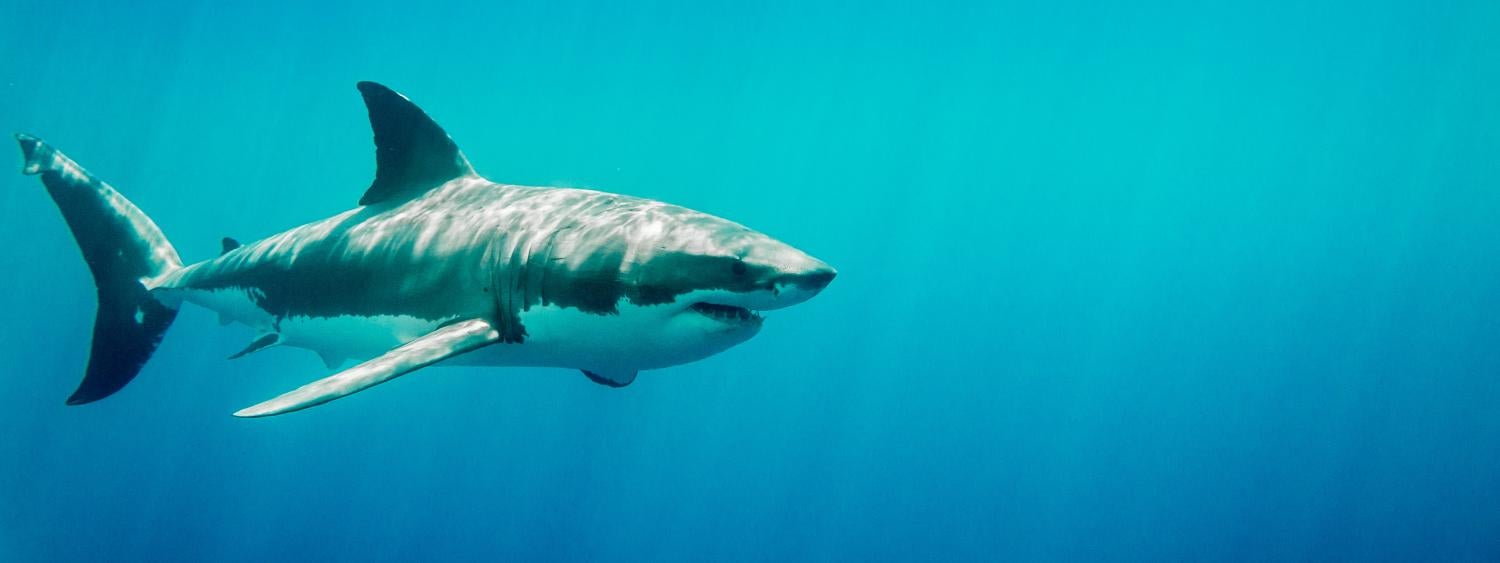CUriosity: Are sharks really as scary as their reputation?
In CUriosity, experts across the CU Boulder campus answer pressing questions about humans, our planet and the universe beyond.
This week, Andrew Martin, a professor of ecology and evolutionary biology, answers: “Are sharks really as scary as their reputation?”

Credit: Adobe Stock
A 14-foot male white shark, the largest ever tagged, is currently making its way north up the Atlantic coast—last week pinging 22 miles off Cape Hatteras—just in time for the 50th anniversary of “Jaws” Friday.
Yes, it’s been 50 years since moviegoers were scared out of the water by a film that presented sharks as terrifying monsters of the deep. Now, it can be difficult to separate fact from fiction in sharks’ scary reputation.
Andrew Martin, a University of Colorado Boulder professor of ecology and evolutionary biology, has studied sharks as a PhD student at the University of Hawaii and throughout his career, which has included working at the Smithsonian Tropical Research Institute in Panama. He addressed some common conceptions—or misconceptions—about sharks to help illuminate whether they’re as scary as they seem.
Fact or fiction: “Jaws” was good for sharks.
Fiction.
“Jaws” was a terrible thing for sharks and a terrible thing for biology. I think it scared people away from the ocean, which was a bummer, and I know Peter Benchley, author of the novel “Jaws,” has come around and realized his mistake. We were easy prey for him, in a way, because we were already a little bit scared of the ocean. I mean, what could be more terrifying? All you want to do is have fun at the beach.
However, encounters between humans and great whites are usually with surfers, who look like seals from below. It’s really rare for a shark to go after someone.
Fact or fiction: All sharks will attack humans.
Fiction.
That’s definitely not true. There are hundreds of species of sharks, and I can count the number of species that have a record of attacking humans on one hand.
Fact or fiction: Sharks are apex predators.
Depends.
Great white sharks are pretty much an apex predator because they will feed on things that are also very high in the food chain. I don’t know how useful the term “apex” is, though, because it implies there’s only one thing at the very top, and if that’s the case then it’s humans because we literally eat everything. In general, sharks are high on the food chain but in some cases not super high. In some food chains they’re not even as high as tuna.
Fact or fiction: Sharks can detect a single drop of blood in the water
Depends.
Most things living in water have a very good sensory capacity for molecules. Still, I’ve been on shark boats where they chum—and it’s not a little bit of chum. It’s a lot of gory stuff they’re dumping in the water—and it still took a lot of time for sharks to come.
Fact or fiction: If sharks stop moving, they die.
Fiction.

Andrew Martin
There are a bunch of species that can sit on the ocean bottom. It’s also true that they do need to pass water over their gills, but they don’t have to move all the time. Some of them do have a pretty high activity level, and they’re moving a lot, but that doesn’t mean they’re going to die if they stop. They’re really well designed to move through the water, so it doesn’t cost them much energy. Because they’re probably always hungry, they seem to be in motion all the time, and that’s the life of almost everything on this planet.
Fact or fiction: Sharks haven’t changed since prehistoric times.
Depends.
We don’t have a good fossil record for their bodies, since they have cartilage instead of bones, but their teeth fossilize really well, and we have really good evidence that a lot of shark teeth haven’t changed much over time. However, we do know—mostly from phylogenetic reconstructions—that some sharks have evolved and changed over time. In the group of sharks that great whites are in, named the Lamniformes, there are several divergent groups of species that have evolved the ability to elevate their temperature well above the temperature of their environment. This ability, which involves changes in many different aspects of their biology, has evolved more than once.
A good example of this is thresher sharks that have a really long tail, and they can go through schools of fish, whip that tail around and knock out fish. Their body and brain temperatures are warmer than the water, so they can generate a lot of power—power is proportional to temperature—and keep their nervous system and brain warmer, so they can process information faster. The result is that they are better, more efficient and perhaps scarier predators if you are a small fish.



